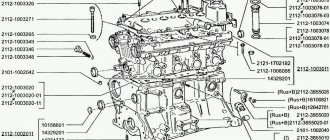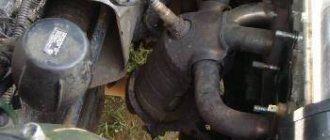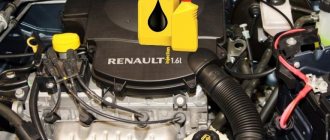February 17, 2015 Lada.Online 430 821 31
Depending on the year of manufacture, the Largus may be equipped with a Renault or VAZ engine. Currently, only domestic engines are installed on this car. Let's take a closer look at the technical characteristics of Lada Largus engines, as well as the features of their assembly.
- Renault-Nissan K7M
(8 valves) with a volume of 1.6 liters is capable of developing a power of 84 hp. This motor is installed on the “standard” and “norm” configurations. - Renault-Nissan K4M
(16 valves) is slightly more powerful, also 1.6 liters, but has a power of 105 hp. or 77 kW. The motor is provided for the “luxury” configuration. - VAZ 11189
(1.6 liter, 87 hp, 8 valves) began to be installed instead of K7M in 2015. - VAZ 21129
(1.6 liter, 106 hp, 16 valves) began to be installed instead of Renault K4M in October 2021. - VAZ 11182
(1.6l., 90hp, 8kl) began to be installed on Largus FL from March 2021
Both are Renault Alliance engines. Since December 2015, AVTOVAZ began installing its 8-valve VAZ-11189 engine. You can get acquainted with its pros and cons from this review.
Both engines from Renault-Nissan are paired with a 5-speed manual transmission. At the moment, AVTOVAZ does not plan to equip the Lada Largus with an automatic transmission.
Lada Largus engines are distinguished by high elasticity, and the manual gearbox is distinguished by precise gear shifting. For dynamic acceleration and confident overtaking, the engine power is quite enough. Both Lada Largus engines comply with Euro 4 environmental requirements.
Depending on the vehicle configuration, there are several options for installing auxiliary equipment on the engine:
- car with non-power steering;
- car without power steering with air conditioning;
- vehicle with hydraulic power steering;
- car with hydraulic power steering and air conditioning.
Technical characteristics of Renault engines
| Options | Engine model | |
| RENAULT, K4M | RENAULT, K7M | |
| Injection type | Electronically controlled multipoint fuel injection | |
| Fuel type | Gasoline Premium-95 GOST 51105-97 | |
| Number and arrangement of cylinders | 4, in-line | |
| Number of valves | 16 | 8 |
| Cylinder operating order | 1-3-4-2 | |
| Direction of rotation of the crankshaft (camshaft drive side) | ||
| right | ||
| Cylinder diameter/piston stroke, mm | 79,5×80,5 | |
| Working volume, cm3 | 1598 | |
| Compression ratio | 9,8 | 9,5 |
| Toxicity standards | Euro 4 | |
| Power at 5500 rpm, kW (hp) | — | 62 (84) |
| Power at 5750 rpm, kW (hp) | 77 (105) | — |
| Maximum torque, N.m (at rpm) | 148 (3750) | 124 (3000) |
| Volume of oil poured into the engine lubrication system, including oil filter, l | 4,8 | 3,3 |
Description of the K7M engine (Renault Logan/Sandero/Largus)
In 2010, the K7M 800 engine appeared, which replaced the K7M 710. No design changes occurred, except that the engine was strangled, bringing it up to the Euro-4 environmental standard, while the power decreased from 86 hp to 83 hp. With.
The disadvantages of the engine remain the same:
- high fuel consumption.
- At idle the speed often fluctuates.
- Every 20-30 thousand km the valves need to be adjusted.
- no hydraulic compensators.
- If the belt breaks, the valve bends; it is recommended to change the belt every 60 thousand km.
- crankshaft oil seal leaking.
- the engine is noisy.
- there are vibrations during operation.
If you look at the engine from the positive side, it is worth noting its high reliability; according to the passport, the engine life is about 400 thousand km, but in practice it is a little more.
Engine tuning
Many motorists want to make their engines better and more powerful. This is why the tuning and modification procedure is carried out. For engines such as the Lada Largus, there are two options for modification - mechanical and software tuning. But, most vehicle owners prefer to make a second modification.
So, what is meant by software modification - chip tuning Largus. Chipping engines is a common procedure these days. In this case, there are two subtypes of the operation. Let's look at each one separately.
Soldering the chip into the ECU
In order for everything to work out and not have to often stand in line to see an electrician-programmer, the ideal option is to install a chip in the engine control unit. After this, the software is installed, and subsequently the chip regulates the operation of all necessary systems.
How is the actual process of introducing a chip into the “brains” of a vehicle carried out? This procedure is quite difficult and requires advanced knowledge in radio electronics, as well as automotive electrical engineering. So, this process is best left to specialists.
The chip itself can be mounted (soldered) directly into the electronic engine control unit or at an intermediate stage, depending on the purpose of the equipment.
Recently, controllers and various chips that motorists install into their cars themselves have become popular. As practice shows, this does not always have a positive effect on the performance of automotive systems. Experts and auto electricians recommend that before installing anything in a vehicle, consult with professionals and weigh all the pros and cons.
Brain firmware
The second option is chipping the standard engine control unit. Motorists and craftsmen divide this type of tuning into three parts:
- Firmware to reduce fuel consumption.
- Firmware to increase power.
- Balanced firmware.
As practice shows, most owners of Largus engines use the option with reduced consumption. It is worth understanding that by reducing the flow rate, the dynamic characteristics are also reduced. Thus, power units may respond late to changes in the position of the accelerator pedal, which in turn does not have a very good effect when overtaking.
The big advantages of chip tuning include balanced chipping. This option is the most suitable for the engine itself. Thus, the fuel mixture is supplied in the required quantity to the cylinders, and combustion occurs completely, since the ignition timing is set ideally.
It is worth noting that the chipping procedure must be trusted to professionals. Only they will tell you what type of tuning is most suitable for the engine and will take into account the wishes of the motorist.
Description of the K4M engine (Renault Logan/Sandero/Largus)
It is a development of the K7M series, with a new cylinder head, already 16 valve. There are many differences: K4M is quieter, it is more economical, there are no vibrations and many other advantages.
Motor disadvantages:
- expensive spare parts.
- If the belt breaks, the valve bends; it is recommended to change the belt every 60 thousand km.
- there are failures in work.
- Low-quality fuel causes the revs to fluctuate.
- troit (most often the problem is in the ignition coil, injectors or spark plugs).
- Unstable operation and floating speed are usually caused by the crankshaft position sensor or ignition coil.
If you choose between K7M and K4M, then the choice should definitely remain with the more modern and practical K4M.
Whose engine is Lada Largus
Previously, engines for Lada Largus came assembled from the Renault plant in Spain, but recently engines of the K4M series (16 valves, 105 hp) began to be assembled at AVTOVAZ. According to the director of the Power Units project, Francois Goujon, the quality of engines assembled at AVTOVAZ corresponds to the world level.
The AVTOVAZ press service assures that a quality system is used in the production of new engines to ensure that products comply with the international standards of the alliance. In addition to personnel training, it includes control on the production line, during which each assembled engine is tested in different modes on a special stand. The technology also provides for a weekly check, when one of the motors is completely disassembled and the quality of its assembly is analyzed.
Content
The situation in Russia is such that most families can afford a maximum of one car. And the best body for them is a large station wagon, which can accommodate all family members, pets, belongings and garden seedlings. The new car market offers few station wagons, and those that are sold do not fit into the budget of the average family. For such cars, Russian buyers go to the secondary market.
In this material we offer an overview of the Russian station wagon Lada Largus, for which on average they ask for 463 thousand rubles. The model has been produced since 2012 in three body types: a van, a five-door station wagon and a cross-version of the station wagon. “Largus” has only one generation so far; there have been no restylings or updates yet.
About the domestic VAZ 11189 engine
In April 2021, AVTOVAZ began installing domestic VAZ 11189 engines on Largus. The advantages of this engine are described in one of the issues of “Okay Mechanics”.
| Some measurement results Autoreview | |||
| Options | Cars | ||
| Lada Largus (VAZ engine) | Lada Largus (Renault engine) | ||
| Maximum speed, km/h | 157,1/156,7* | 168,0/167,6 | |
| Acceleration time, s | 0—50 km/h | 4,3/4,8 | 3,9/4,4 |
| 0—100 km/h | 13,9/16,8 | 12,5/14,5 | |
| 0—150 km/h | 61,1/71,6 | 38,9/43,7 | |
| on the way 400 m | 19,3/20,2 | 18,4/19,4 | |
| on the way 1000 m | 36,1/37,8 | 34,1/36,0 | |
| 60-100 km/h (III) | 8,7/10,6 | 9,3/10,6 | |
| 60-100 km/h (IV) | 12,1/15,1 | 12,8/14,1 | |
| 80-120 km/h (V) | 19,3/24,0 | 22,1/23,4 | |
| * Partial load/full load | |||
| Engine characteristics | ||
| Options | VAZ-11189 | Renault K4M |
| Volume, cm3 | 1596 | 1598 |
| Number of valves | 8 | 16 |
| Maximum power, hp/kW/rpm | 87/64/5100 | 102/75/5750 |
| Maximum torque, Nm/rpm | 140/3800 | 145/3750 |
| Cylinder diameter/piston stroke, mm | 82,0/ 75,6 | 79,5/80,5 |
| Compression ratio | 10,3:1 | 9,8:1 |
| Injection type | distributed, electronically controlled | |
| Octane number of gasoline | at least 92 | not less than 95 |
How does the Cross version differ from the regular one?
The prefix “cross” to a model name almost always means an artificially created illusion of a crossover. In the case of the Largus, these are unpainted bumpers and plastic linings on the arches and sills, so as not to scratch the most vulnerable parts of the body on dirt roads. The regular Largus is equipped with 15-inch wheels, while the Largus Cross is equipped with 16-inch wheels. The ground clearance of the cross version is 210 mm, while on the regular Largus it is 185 mm.
Car interiors are almost no different from each other. In the cross version, the seats are decorated with oblique stitching, and the dashboard is made of two colors.
For the cross version, the engineers even changed the suspension slightly: the shock absorber body and rear springs are longer. This allows you to feel more comfortable when driving on bad roads than on a regular Largus.
At the same time, Largus Cross spends 1.5 liters of gasoline more than a regular station wagon: 11.5 liters versus 10 liters per 100 km!
Also read: Rare Ladas on the secondary market
New VAZ 11182 engine
At the beginning of 2021, AVTOVAZ introduced a new 8-valve 1.6-liter engine (VAZ 11182 or AR16SEg2), which first appeared on the Lada Largus FL and will later appear on the Lada Granta FL.
AVTOVAZ writes that the new engine featured an updated connecting rod and piston group, a modernized crankshaft and a gas distribution mechanism. As a result, power is increased to 90 hp, and 80% of torque is available from 1000 rpm, which reduces fuel consumption and reduces shift frequency. In addition, the need to adjust valves before a mileage of 90,000 kilometers is eliminated. The engine is adapted to run on gasoline with an octane rating of 92. Read more about the design in this review. Technical characteristics and reviews about it are at the link.
Let us remind you that you can read about the VAZ 21129 engine here.
Key words: Lada Largus engine
+23
Share on social networks:
Found an error? Select it and press Ctrl+Enter..
What is the reason for its popularity: the advantages of Lada Largus
There is no need to judge the appearance of the Largus: the current station wagon is a copy of the Dacia Duster MCV, originally from the early 2000s. AvtoVAZ designers did not bother to change the appearance of the model, but this did not scare off the target audience: practical drivers do not put design at the forefront.
The main trump cards of the domestic “heel” are capacity and price. From a car with a spacious trunk of more than 600 liters, the interior is transformed into a seven-seater car. And with two rows of seats folded, a fifth dimension opens up, containing almost 2.5 thousand liters of cargo! At the same time, the third row of seats is by no means just for show, like many crossovers.
Not only legless dwarfs, tiny animals or children will be able to sit comfortably in the last row. Even two adults of standard build and height can survive a long trip there, because a seven-seater cabin is needed not only by large families, but also by those who have many friends. And thanks to the rectangular shape of the body and interior trim without bevels, it is easy to carry long items in the trunk: boards, building materials, oversized cargo, etc. Practicality is the Largus’s ace in the hole.
Low cost is the second plus of the model. Maintenance costs are also low and spare parts are easy to find. Simple optics and a primitive design in this case play into the hands of the model. No matter how much journalists talk about how “Lada rises from its knees,” Togliatti has not yet learned how to assemble reliable automatic transmissions, let alone more complex and smart designs. Therefore, the simpler, the more reliable and cheaper.
Read also: Maximum amount of insurance compensation
Another advantage of the model is its ground clearance. For the regular version of LADA Largus it reaches 170 mm, for the cross version - 200 mm.











